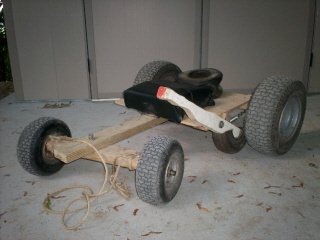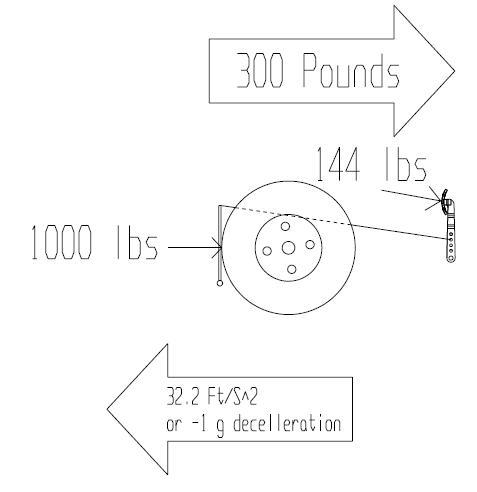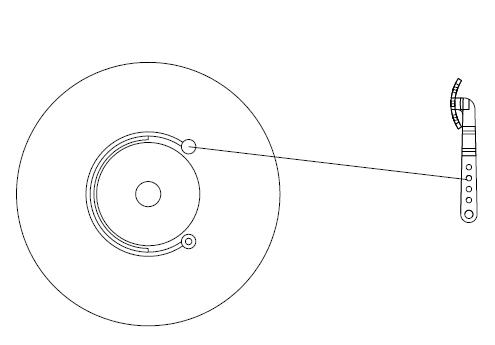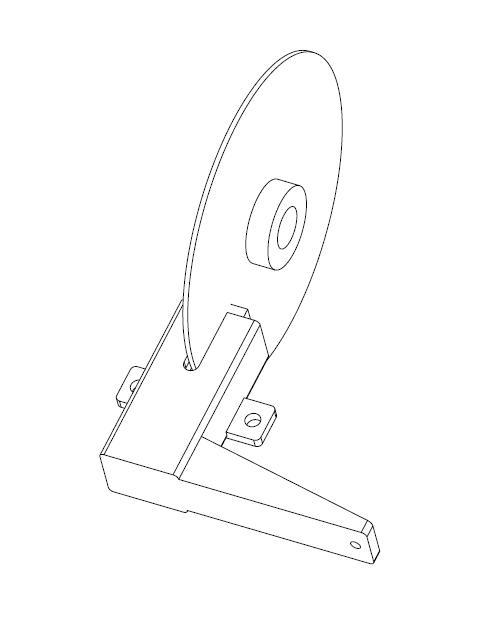I ran into an interesting problem when I was working on my wood go kart. It went way too fast. You might think that going way too fast would be fun. It actually was fun, until you got near something, like a tree, that would end the ride abruptly, and not with out some definite memory of it.
Brakes would have been nice, I thought as extricated myself from the bush. Yep brakes are probably one of the most important things about go karting.

Notice the crude brake put on (after I smashed into a bush): a rubber tire piece that is jammed, or dragged on the ground! Crude, but works!
Just in case you did not know what a brake is, it is technically a device that takes all the forward moving energy and converts it into heat.
What??? Translation, a brake makes you stop, and and stop fast.
That sounds simple enough stopping the vehicle, but how do I do that? Do I put my foot down? Yeah, I have tried that, and burnt the rubber off my shoe, not to mention all the bang and scrape marks on my ankle.
No, putting your feet down is never an option. It might work for kiddy toys, but not for go karts.
Understanding stopping is the key. The energy of the moving vehicle needs to be removed. Kinetic Energy = ½ MV^2. M = mass of the vehicle, V = the velocity. When you stop the vehicle, you can see that V=0, when V=0 then you are sitting still or not moving. Energy then equals zero.
The practical way to transfer the Kinetic Energy is to drag something. The speed of the vehicle is then transferred into Heat Energy as the something dragged is put down. If you ever try putting a stick down on the ground as you are moving, you will notice the stick gets really hot. Additionally, the stick wears down.
Brakes are nothing more than glorified dragging sticks, but are designed to not light on fire, and to actually be used over and over again.
There are three types of brakes used on go karts:
-Tire Rubbing Brakes
-Band Brakes
-Disc Brakes
The tire rubbing brakes take a piece of metal, like aluminum or steel and press it against the tire. It seems pretty basic, but you would be surprised on how much force is required to actually get the wheels to stop. (For a simple 300 pound kart it takes 1000 pounds of force on a plate, to get the tires to stop and fast). It is no wonder it takes a lot of foot force (144 lbs!) to get these style brakes to work.
 Also the down side to rubbing style brakes is that the tires wear out quicker and you will get streaks or tears in your tires due to the rubbing steel plate. There are other versions that use aluminum. One of the go karts I had used that style brake, but the problem was that the aluminum shoes had worn clean through and were starting to tear at the tires. The yellow go kart we had used that style brake.
Also the down side to rubbing style brakes is that the tires wear out quicker and you will get streaks or tears in your tires due to the rubbing steel plate. There are other versions that use aluminum. One of the go karts I had used that style brake, but the problem was that the aluminum shoes had worn clean through and were starting to tear at the tires. The yellow go kart we had used that style brake.
In case you are designing a system that used rubbing brakes, I would suggest that you look in the “How To Build A Go Kart Manual.” In there is a whole section on brake calculations, especially for rubber brakes.
The band brake is a style brake where a drum is wrapped around with a band of braking material. The band is then pulled on and this causes the braking material to rub hard on the drum. A lot of heat is dissipated as the brake is actuated. In fact I have seen then brakes smoke, after a lot of use. The nice thing about a band brake is that is relatively compact.
The disc brake is a style brake, where there is a disc of steel that is rubbed on with friction type material. The friction type material is clamped on both sides of the plate. This style brake as well exerts some pretty hefty heat when it is used a lot.
On my go kart I use a disc style brake, because it is easy to install and maintain. It was also relatively cost effective as well.
 The disc brake is able to disappate the heat better, or quicker than a band /drum brake. The reason why this is, is that the disc has more surface area that is exposed to the air, than does a drum brake. The heat is quickly fanned away from the surface, whereas on the drum brake the heat is retained underneath the band and is not allowed to dissappate away quickly.
The disc brake is able to disappate the heat better, or quicker than a band /drum brake. The reason why this is, is that the disc has more surface area that is exposed to the air, than does a drum brake. The heat is quickly fanned away from the surface, whereas on the drum brake the heat is retained underneath the band and is not allowed to dissappate away quickly.
 Enhancements to the disc style brake are available as well. The enhancements are designed to do two things: make braking more aggressive and disappate heat. Holes will be drilled or holes and slots will be made in the disc. This increases the surface area for heat disappation and also, because heat is taken away, the coefficient of friction stays more stable or higher causing the brake to grab better.
Enhancements to the disc style brake are available as well. The enhancements are designed to do two things: make braking more aggressive and disappate heat. Holes will be drilled or holes and slots will be made in the disc. This increases the surface area for heat disappation and also, because heat is taken away, the coefficient of friction stays more stable or higher causing the brake to grab better.
Disc brakes are also used on all four wheels in higher end go karts, especially when speeds of 50+ mph are concerned. Typically the go kart has a large power band and is bening made to stop and start continually in racing conditions. Usually these brakes are very much like cars in that they are hydraulically actuated. Instead of using a mechanical linkage (like the one shown above) the brakes are applied by using a hydraulic cylinder that pressed on both sides of the disc, in effect clamping braking material on the disc.
If you ever watch some footage of formula race cars and watch the discs as they glow cherry red and then back off in color, you will get the idea of what brakes are doing from an energy transfer process. The Kinetic Energy of the moving vehicle is being transferred into heat (glowing cherry red disc) and then the vehicle slows down. When the vehicle accelerates, the cherry red disc goes back to normal color, because no energy is being dissappated or transferred into the disc.


